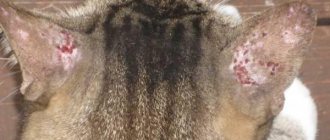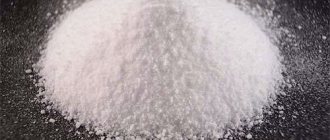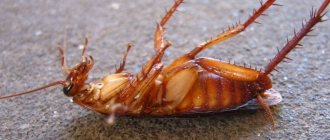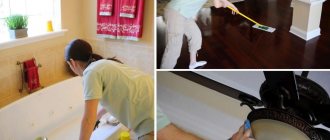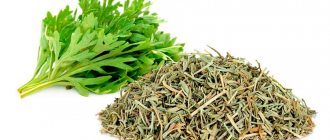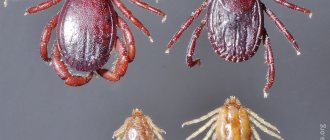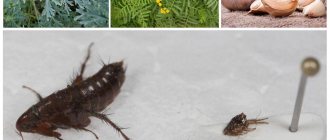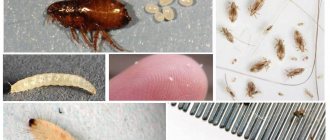To kill fleas at home, you can use natural remedies. The methods of using the components are different: some are applied to the skin, others to the undercoat of pets, others for “disinfection” of the house.
Flea vinegar is an effective natural remedy in the fight against parasites. For practical purposes, apple or wine is used.
It would be useful for anyone who intends to put an end to unpleasant neighborhoods to become familiar with the algorithm for preparing the product and its use, as well as the degree of effectiveness of the solution.
Signs of flea infestation on a dog
In order to start treatment in a timely manner and rid your dog of the problem, you need to know what insects should look like.
The presence of bloodsuckers on a dog can be detected independently. By running a comb against the fur, the larvae are visible to the naked eye, which look like small grains of white color. And the black specks present are flea feces; they are usually found on the skin.
Fleas are agile, brown in color, and can quickly hide in fur. They are afraid of water, so they can be seen while swimming, because... insects jump into the water or move to a dry part of the body (head).
The following signs indicate the presence of fleas:
- The first symptom of a flea infestation is that the dog scratches his entire body continuously.
- The dog may suddenly jump up, trying to bite itself.
- Traces of parasite bites are clearly visible on dogs with short hair, showing up as red spots and wounds.
- The animal becomes restless, irritable, does not sleep, and eats poorly.
- Body weight decreases sharply even with good feeding.
An allergy to the presence of fleas occurs in every fourth dog and indicates:
- hair loss, often in the groin, abdomen, and armpits;
- the appearance of scabs on the body;
- dermatitis.
Since ectoparasites are carriers of serious pathologies, after some time the main symptoms are supplemented by gastrointestinal disorders, changes in the color of mucous membranes, and hyperthermia.
Lemon acid
Citric acid is a natural flea killer, and lemons are full of it. To create a spray that will work on even sensitive skin, boil a lemon solution in water and let it sit overnight. You can then apply the mixture to your cat's fur using a spray bottle, but avoid contact with eyes, open wounds and scratches. A glass of lemon juice can also be used in the washing machine when you wash your cat's bedding to kill all the fleas.
Why are insect bites dangerous?
The constant itching sensation from flea bites is a lesser problem that may bother your dog. There are much more serious problems, namely:
- Fleas carry parasites such as cucumber tapeworm and certain types of worms.
- An animal can become infected with salmonellosis, brucellosis, and plague from fleas.
- When flea saliva enters the dog's body, an allergy develops.
In addition, the pet ingests fleas and helminths that are at intermediate stages of the life cycle, i.e. beginning their development in the dog’s body. Worm infestation poses a danger to the animal, especially if it is a puppy, the dog is weakened, or pregnant. Read more about what fleas look like and how dangerous they are on dogs in the article here.
With severe infestation, fleas can cause anemia in puppies.
To eliminate the risk of diseases and their consequences, annual vaccination of your pet is required.
How to deal with parasites in your pet
Having discovered parasites on an animal, you need to quickly begin treatment. To get rid of fleas on a dog, the veterinarian selects an effective remedy based on the physiological characteristics of the patient.
Of course, you need to use all available means to help exterminate bloodsuckers:
- Homemade recipes.
- Chewable tablets.
- Collar.
- Drops.
- Injections.
To get rid of fleas on dogs using folk remedies, you need to follow 2 main rules:
- Regularity.
- Accuracy.
Folk recipes
Removing fleas from a dog at home using folk recipes is possible only with constant and thorough treatment of the fur with these products. If you do the treatment in violation of the regime, the fleas may come back again.
- Wormwood for parasites in the form of a decoction. You will need 20 grams of dry wormwood leaves and 40 grams of fresh wormwood leaves in 500 ml of water. The product cools and is applied to the dog’s fur. During treatment, fleas will jump off the pet.
- Crush the garlic in a garlic press, then pour the resulting pulp of 2 cloves with 3-4 glasses of water and leave overnight. The next day, the dog needs to wipe its fur with this mixture, especially on the back and withers, where it is difficult to reach.
- Using laundry soap to prepare the solution. You need to boil the eucalyptus leaves, cool and add a little cedar oil, fir oil, pine oil of your choice, and crushed soap. The resulting mixture is used to wash the dog.
- Onions have the same effect as garlic. The onion head is finely chopped, filled with water, and laundry or tar soap is added. Stir the solution and apply to your pet's fur.
- Dilute apple cider vinegar in water in a ratio of 1:3. Apply this solution generously to your pet's body, leaving for an hour. Then this product is washed off and the coat is combed well.
Pills
The drugs are effective and easy to use. But they are not popular in the fight against fleas in dogs, since they do not cure, but only reduce the number of parasites.
It is impossible to choose the dosage and remedy on your own; only a veterinarian prescribes them.
Due to taking pills, most dogs develop an allergic reaction or individual intolerance.
The advantages of tablets include:
- Possibility of use without age restrictions;
- no side effects;
- The tablets are safe to give to dogs from 2 months of age;
- The pills have a pleasant smell and taste.
When the active substance penetrates the dog’s body, it is absorbed into the bloodstream, entering into a chemical relationship with plasma proteins.
When a flea bites an animal, the tablets have a paralytic effect on the parasite, which leads to its destruction. The effect of the drugs on the dog’s body lasts for 3 months.
Powder
Powders are the cheapest medicine. They are produced in veterinary pharmacies from butox. The products are safe, so they can also be used on young dogs.
Powders with powders are not able to protect against the reappearance of parasites, but are used only as a preventive measure, or in case of flea infestation of minor or moderate severity.
The downside of the powder comes down, for example, to maintaining a clean house and a long course of treatment (about 2 weeks).
Sprays
The fastest way to fight parasites is a spray. The effect of the medicine is immediate, the protection remains for 30 days, depending on the manufacturer.
Attention! Before use, you need to read the instructions. This is due to the fact that there are drugs that are intended for the safe removal of fleas from puppies.
Vaccinations
By vaccination we mean an injection of an insecticide, since there is no vaccine against fleas. An injection for dogs against fleas and ticks is effective, its effect lasts for six months. When an insect bites a dog, it receives a dose of a toxic substance, which provokes a disturbance in the flea’s nervous system, after which it dies.
The advantage of injections is the simplicity of the method. To protect your dog, it is enough to give one anti-flea injection. The injection also eliminates the possibility of the drug entering the dog’s gastrointestinal tract, so there is no risk of poisoning.
Collar
A collar is an effective means of ridding your dog of bloodsuckers. It is suitable for everyday prevention. The collar is made of plastic and contains medicine to repel fleas. Although slowly, this product surrounds the animal with a protective layer.
The collar is put on and not taken off, its effect is gradual. The main thing is that it hangs around the dog’s neck all the time, otherwise the whole effect will be lost. The validity period of the collar is indicated in the attached instructions. Each collar has its own concentration of the substance, which is suitable for certain breeds of dogs.
When purchasing a product, you need to consider the following points:
- The collar is prohibited for dogs to wear during pregnancy, feeding, or if they have a disease;
- do not put a collar on puppies under 6 months, adult animals over 10 years old;
- certain types of collars have a poisonous effect not only on fleas, but also on dogs;
- If you wear this product for a long time, dermatitis may develop.
Drops
Drops are a convenient and effective means for removing parasites. But their effect does not begin immediately, but appears after 2 days. These days, washing the dog is prohibited, otherwise the product will be washed off and will not work.
Important! When choosing drops, you must carefully read the instructions, taking into account the age of your pet. Most products should not be used to remove fleas on puppies under 3 months of age.
Rating of the best flea and tick drops for dogs
Shampoos
Shampoo is a modern drug, it is often prescribed to combat bloodsuckers in young dogs.
The active antiparasitic substance in flea shampoos for dogs is insecticides. Note that it not only has a depressing effect on the vital activity of fleas, but also in some cases causes side effects in dogs.
If the shampoo does not contain insecticides, it can be used more than once a month as a preventive measure against the occurrence of fleas in the dog.
Medicine prices
Cost of anti-flea drugs in Russia:
- Lugovoy shampoo 270 ml – 140-155 rubles;
- Drops Bars 4 pcs. 1.8 ml – 260-275 rubles;
- Celandine collar – 90-100 rubles;.
- Bravecto tablets – 1250-1700 rubles;
- Eprimek injections 100 ml – 720-750 rub.
Prices for products in Ukraine:
- Phytoelite shampoo 220 ml – 43-45 UAH;
- Spray Frontline 250 ml – 600-650 UAH;
- Frontline drops 1 pipette – 210-215 UAH;
- Bravecto tablets – 680-685 UAH;
- Collar Mister Zoo – 15-20 UAH.
How to give your dog vinegar internally to prevent diseases
Acid can also be used to prevent infections. In this case, use natural apple cider vinegar. Other types will not work.
What is the best way to give vinegar?
It is best to give vinegar to your dog with water. Another option is to pour it directly into the mouth for a one-time dose. Dosage for one day - 1 tsp.
What not to give with
You should not add acetic acid to food. Due to moisture, dry food will swell, and other food will acquire an odor that will scare away your pet.
Should you give your dog a vinegar solution?
Not really
Animal handling rules
When a dog is diagnosed and prescribed a remedy, you must strictly follow the prescribed dosage and frequency of treatment with an insectoacaricidal agent.
How to use medications correctly:
- Shampoos. First, the pet is combed with a brush with thick bristles, then bathes for 5 minutes in the bathroom. Water for water treatments should be 37 degrees. You can treat wet wool with the product, lather it, and rinse off after 5 minutes. The dog's coat must be completely dry after bathing, so the animal must remain in a heated room all this time.
- Drops should be applied from the back of the head to the withers of the animal. In this case, you need to part the fur so that the drug gets on the skin. Next, the active substances penetrate the skin, then into the bloodstream, providing an antiparasitic effect. The procedure is carried out using rubber gloves. To prevent licking of the product, the pet is wearing a protective collar.
- The spray is applied by sprinkling evenly over the dog's body. The head is not sprayed, so as not to accidentally spray into the eye area or mouth. For better penetration of the medicine onto the skin, the fur should be straightened with your hands. When the product is applied, the dog needs to be occupied so that he does not lick himself. Even though it is a chemical, like any medicine, there is an acceptable amount that can be accidentally ingested.
- The powder is used in rare cases. The entire animal is treated so that the substance gets on the skin, except for the genital area and muzzle. After treatment, the dog's fur is combed out using a thick brush.
- Chewable tablets are given to the dog in the required dose according to the instructions, which the dog should eat along with food.
- Flea collars are worn after the animal has been rid of parasites to prevent relapse. It is important to strictly observe the timing of wearing the collar and change it in a timely manner.
- The injections are prescribed by a veterinarian and administered in the clinic. Unauthorized treatment with injections is unacceptable.
Regardless of the drug chosen to remove insects, the animal must be given antihistamines.
How to enhance the effect of using folk remedies
If you make a garlic solution, then add 2 tsp to it to enhance the effect. brewer's yeast. Herbal solutions are not just watered, but soaked into the pet’s skin. If you use essential oils, it is recommended to mix several types at once.
When processing an animal, the entire room must be disinfected. Otherwise, fleas may temporarily find another habitat and then return to the pet’s fur. After treatment with products with strong odors, the room is ventilated at least after 8 hours.
The nuances of flea removal
When choosing a remedy for bloodsuckers for an pregnant bitch or a puppy, it is important to first consult with a veterinarian.
Rating of effective flea and tick remedies for dogs
In a pregnant dog
To rid a pregnant dog of bloodsuckers, it is recommended to use folk recipes. But in case of multiple insect infestations, you should choose strong-acting agents.
Pregnant animals are prohibited from wearing a collar, and regarding other options, it is recommended to use drops - Advocate, Frontline. If the bitch tolerates water treatments calmly, then you can use shampoo as a treatment.
In puppies
It is more difficult for young dogs to destroy insects than for adults, because most of the products on the market are only suitable for animals from 6 months of age.
20 effective remedies to get rid of fleas on a puppy
List of acceptable drugs.
- Stronghold spray, Bars, Ftoelita shampoo, Celandine - from 1.5 months of age.
- Drops Celandine, Frontline, Beafar collar - from 2 months of life.
Before taking each product, it is important to read the instructions in order to rid the animal of insects and prevent it from becoming intoxicated.
Interesting! The ideal means to combat parasites in puppies are wormwood and tar soap.
How to treat wool with vinegar to make it shine
To treat wool, dilute 6% vinegar in equal quantities with water. Wipe the fur with it after every walk and comb it. This treatment will add shine and rich natural color.
Acetic acid is used almost everywhere, removes odors, and disinfects. But that is not all. See how to descale a kettle with soda and citric acid, and expand your knowledge about vinegar.
Protecting your pet during walks and everyday life
It is better to follow preventive measures than to get rid of bloodsuckers.
Prevention methods
To reduce the risk of parasite infection, dog owners should adhere to the following preventive measures:
- carry out regular treatment, disinfection and replacement of the pet’s bed;
- keep your home clean;
- wash the enclosure, booth;
- examine the dog after going out into the yard, walking, mating;
- protect the dog from contact with other dogs;
- wear a flea collar;
- As a preventative measure, treat the animal with appropriate drops 2 times a year.
Fleas will not appear if you follow these measures. If you are unable to remove bloodsuckers from your animal on your own, you need to make an appointment with a veterinarian.
Security Overview
Preparations for insects that live on a pet’s body can have a repellent, destructive or complex effect. Many drugs against ectoparasites have a wide spectrum of action; they both repel and destroy insects.
How long the medicine will act depends on the properties and concentration of the main elements of the drug.
Medicines to protect against bloodsuckers:
- Tablets - Bravecto, Simparica, Comfortis, Frontline, Nexgard;
- Sprays – Frontline, Bars, Hearts;
- Injections – Ivermectin, Eprimek, Lufenuron;
- Collars – Bars, Hearts, Celandine, Foresta;
- Drops – Celandine, Barrier, Advocate, Advantix, Bars forte;
- Shampoos – FitoElita, Dana, Lugovoi, Bars;
- Powder – Celandine, Sanal, Insectal.
Spices
One of the easiest things you can do for a flea-infested cat is to revive its life with natural ingredients you can find in your kitchen. Because of a natural compound known as carvacrol, oregano oil can be very effective in removing fleas.
Start by mixing one teaspoon of oregano oil with three teaspoons of olive oil and apply a small amount of the solution to areas where fleas tend to congregate, such as your cat's ears, belly, tail, and neck. Fleas don't particularly like rosemary either; Try grinding the leaves into a powder and sprinkling it on areas where your cat usually hangs out in your home.
If your cat won't allow you to apply topicals to her fur, you can try adding a small amount (less than a teaspoon) of cumin to your cat's food. The spice will make your cat's skin completely unappetizing for fleas.
If you don't have any of these spices on hand, a little table salt can also help as it helps hydrate and kill fleas on your cat. What's more, it kills fleas and flea eggs that may be lurking on your carpet (just sprinkle water on it), and when mixed with water, it can be used on hard surfaces.
Warning ! These spices are a safe alternative to garlic powder, which can be toxic to cats in large doses.
We carry out disinfection of the premises
To eliminate parasites from a dog, it is not enough to just treat the dog. The bloodsuckers that live nearby will come back again after the medicine expires. As a result, it is necessary to simultaneously clean the living quarters and the booth in which the animal lives. To disinfest an apartment, you can use one of the following methods:
- Heat treatment. In winter, things are taken out into the cold; a couple of hours are enough for the parasites to die. You can kill fleas by boiling or pouring boiling water over things.
- Chemical substances. The floor, walls, corners, utility rooms are treated with Karbofos, Reid, Fenaxin. They resort to insecticidal agents - sprays, powders, which were used to treat the animal.
- Home methods. To clean the room, use wormwood, kerosene, and pine sawdust. The death of parasites is possible with kerosene disinfestation. Using prepared decoctions and infusions from plants, wipe all surfaces in the room 2-3 times a day. Lay out the wormwood where the baseboard goes, in the corners, under the furniture. Regularly add a new portion when the previous one dries out.
- Professional services services. In difficult situations and when the methods of control used are ineffective, they turn to specialized services. Treatment by professionals involves the artificial organization of fine particles of steam that contain an insecticide. Particles settle, getting inside porous materials, causing the death of bloodsuckers.
The pet's kennel also requires treatment. The same methods are used as in the house. The animal's bedding is burned. To prevent the return of insects, wormwood and tansy are placed around the booth and in it.
To choose the right drug for bloodsuckers, it is better to consult a veterinarian. He will prescribe a remedy that will correspond to the age and other characteristics of the pet.
FAQ
Answers to frequently asked questions will help you avoid mistakes during the processing process. Familiarize yourself with them in advance so that unforeseen situations do not take you by surprise.
What to do if you burn your dog's paw with vinegar
Rub the damaged area with soothing oil or strong, chilled tea. Contact your veterinarian as soon as the itching and irritation subsides. He will assess the extent of the damage and prescribe appropriate treatment.
First aid if your dog accidentally drinks vinegar
If this situation occurs, you should immediately consult a doctor. Only he can provide qualified assistance in this case.
Why does my dog smell like vinegar?
This may occur because the vinegar was diluted in too small a proportion. Washing the dog again using soap or any other detergent will help eliminate the unpleasant odor.
Does your dog tolerate vinegar well?
Not really
Are dogs afraid of the smell of vinegar?
The pet is not afraid of the smell of acid. However, there is no clear answer to how dogs react to the smell of vinegar. Each animal is individual in this regard: some show aggression, while in others it does not cause any changes in behavior.

